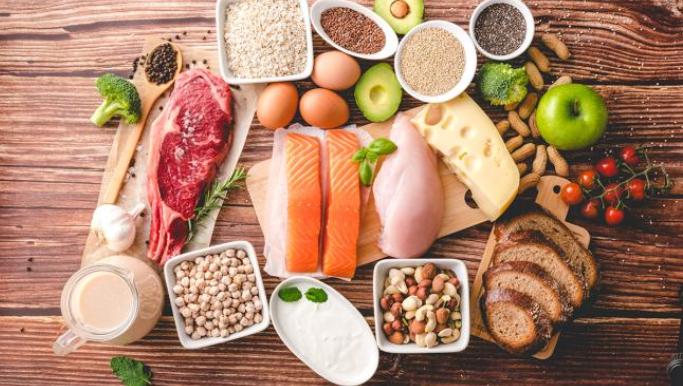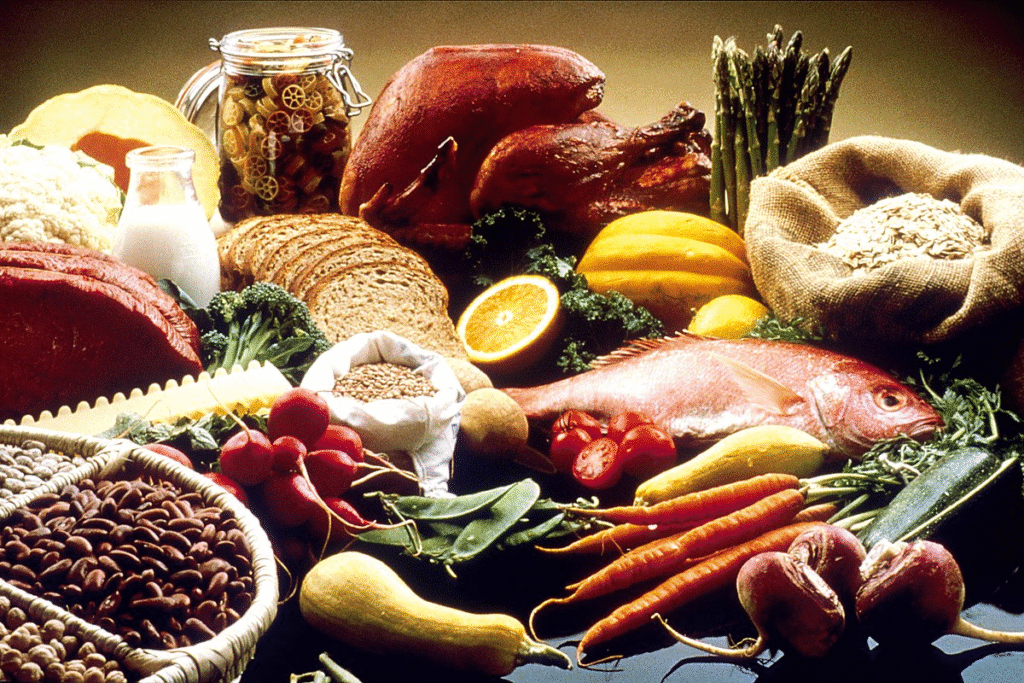
Protective food is the kind of food that helps keep our body safe from sickness. These foods are full of vitamins and minerals that make our immune system strong. When we eat protective food every day, we feel better, have more energy, and don’t fall sick easily. Fruits like oranges, vegetables like spinach, and even nuts like almonds are some great examples. These foods protect our body just like an umbrella protects us from rain. Children, adults, and even older people need protective food to stay healthy. If we don’t eat enough protective food, our body may get weak, and we might feel tired all the time. That’s why it’s important to eat these foods in our daily meals.
Many people think only medicine can keep them healthy, but food plays a big role too. Protective food is like nature’s medicine. It doesn’t just stop us from getting sick but also helps our body grow strong and heal faster. For example, if you get a cut, your body needs vitamins to help close the wound. That’s what protective foods do—they give your body the power to fix itself. Protective food also helps our eyes see better, our skin glow, and our bones stay strong. It’s not about eating fancy or expensive things—it’s about picking simple, healthy items like carrots, papaya, or milk that help our body stay in good shape. Even one small serving of these healthy foods every day can make a big difference. So let’s learn more about protective food and how it keeps our body safe and strong.
Why Is Protective Food Important
Protective food is very important because it keeps our body safe from many health problems. Without protective food, we can get sick more often. For example, if we don’t eat fruits or vegetables, we may not get enough vitamins like Vitamin C or Vitamin A. These vitamins are needed to keep our eyes, skin, and immune system healthy. When our immune system is weak, we can easily catch diseases.
Protective food also helps our body heal faster when we are hurt. It makes our bones strong, helps in blood flow, and supports good digestion. Children need protective food to grow well. Adults need it to stay fit, and older people need it to stay active and avoid weakness. Protective food also helps us feel good inside, reducing stress and making us feel happy.
Types of Protective Food
There are many types of protective food. Each one gives different nutrients to the body. Here are some of the main types:
1. Fruits – Fruits like oranges, bananas, apples, papaya, and mangoes are full of vitamins and fiber. They help in keeping our body strong and fresh.
2. Vegetables – Green leafy vegetables like spinach, kale, and broccoli are very good for health. Carrots and beets help improve blood and vision.
3. Milk and Dairy – Milk, yogurt, and cheese give calcium and Vitamin D. These help to build strong bones and teeth.
4. Nuts and Seeds – Almonds, walnuts, flax seeds, and sunflower seeds give us healthy fats and help the brain and heart.
5. Eggs and Fish – These are also considered protective as they provide vitamins and minerals like Omega-3 fatty acids.
These foods are easy to find and can be added to meals without much effort.
Nutrients Found in Protective Food

Protective foods are full of important nutrients. Each nutrient does something special in our body. Let’s look at some of them:
Vitamin C – Found in oranges, lemons, and guava. It helps fight colds and makes skin healthy.
Vitamin A – Found in carrots, spinach, and sweet potatoes. It is good for the eyes and skin.
Vitamin D – Found in milk, eggs, and sunlight. It makes bones strong.
Iron – Found in green leafy vegetables, dates, and beans. It helps make blood and gives energy.
Calcium – Found in milk and cheese. It makes teeth and bones strong.
Fiber – Found in fruits and whole grains. It helps in digestion and keeps the stomach clean.
When we eat a mix of protective foods, we get all these nutrients to keep us healthy.
Benefits of Eating Protective Food
There are many benefits to eating protective food. Here are some of the most important ones:
- Fights Sickness – Protective food builds a strong immune system. This helps us avoid colds, flu, and infections.
- Healthy Growth – Children grow taller and stronger when they eat protective foods.
- Stronger Bones and Teeth – With the help of calcium and Vitamin D, our bones and teeth stay strong.
- Healthy Skin and Hair – Protective food makes our skin glow and keeps our hair shiny and soft.
- Better Brain Power – Some foods help us think better and improve memory.
- Fast Healing – When we are hurt or sick, protective food helps the body heal quickly.
- Good Digestion – Protective food has fiber that helps us digest food well.
These are just a few of the many benefits. Eating protective food every day is the best way to stay fit and healthy.
Best Protective Foods to Add to Your Diet
Here is a simple list of protective foods you can eat daily:
- Oranges, lemons, and other citrus fruits
- Bananas, apples, and papaya
- Carrots, beets, and sweet potatoes
- Spinach, broccoli, and other green vegetables
- Milk, cheese, and yogurt
- Eggs and fish
- Almonds, peanuts, and walnuts
- Sunflower seeds and pumpkin seeds
- Whole grains like oats and brown rice
You don’t have to eat all of them every day. Just pick a few and add them to your meals.
Simple Ways to Eat More Protective Food

Many people find it hard to eat healthy food every day. But it’s actually easy if you plan a little. Here are some fun and simple ways to eat more protective food:
- Make fruit salad – Mix your favorite fruits and add a little honey or lemon juice.
- Add veggies to your meals – Put spinach in dal or make carrot parathas.
- Drink smoothies – Blend banana, milk, and nuts together.
- Eat dry fruits as snacks – Keep almonds or raisins in your bag for quick energy.
- Use yogurt in lunch – It’s tasty and full of good bacteria for your tummy.
- Make veggie sandwiches – Use cucumber, tomato, and lettuce.
Even kids can enjoy these meals if made in a fun and colorful way.
Protective Food for Children
Children need protective food the most because they are still growing. If kids eat junk food all the time, they may get sick or feel tired. But if they eat protective food, they become smart, strong, and full of energy. Parents can pack fruits, boiled eggs, or nut mixes in lunch boxes. Fun shapes like fruit stars or smiley sandwiches also help children enjoy healthy food.
You can also make protective food fun by telling stories about superhero fruits or veggie warriors who fight germs in the body. That way, children will get excited to eat them every day.
Protective Food for Older People
As people grow older, their body becomes weaker. They may not eat much or feel hungry. That’s why protective food is very important for them. It helps them stay active, sleep better, and avoid sickness. Older people should eat soft fruits like bananas, cooked vegetables, and drink milk. Soups and smoothies are also good options. These are easy to digest and full of nutrients.
If older people eat protective food regularly, they can stay strong and do their daily work without getting tired easily.
Protective Food vs Body-Building Food

Some people think protective food and body-building food are the same. But they are not. Protective food helps us fight sickness and stay healthy. Body-building food helps us grow muscles and become strong. Examples of body-building food are pulses, meat, eggs, and milk.
Our body needs both kinds of food. Protective food keeps us safe from diseases, and body-building food helps us grow. So it’s good to eat both in a balanced way.
Conclusion
Protective food is very important for a happy and healthy life. It gives our body the power to fight germs and helps us stay strong. From fruits and vegetables to milk and nuts, there are many easy ways to include protective food in daily meals. Whether you are a child, an adult, or an older person, eating protective food can help you live better and feel better. Make it a habit to add at least one or two protective foods to your plate every day. Remember, good health starts with good food.
FAQs
What is protective food?
Protective food is food that protects the body from diseases. It is full of vitamins, minerals, and other nutrients.
Why is protective food important for children?
It helps children grow strong, stay active, and avoid sickness.
Can protective food help us heal faster?
Yes, it helps in faster healing of wounds and sickness by boosting the immune system.